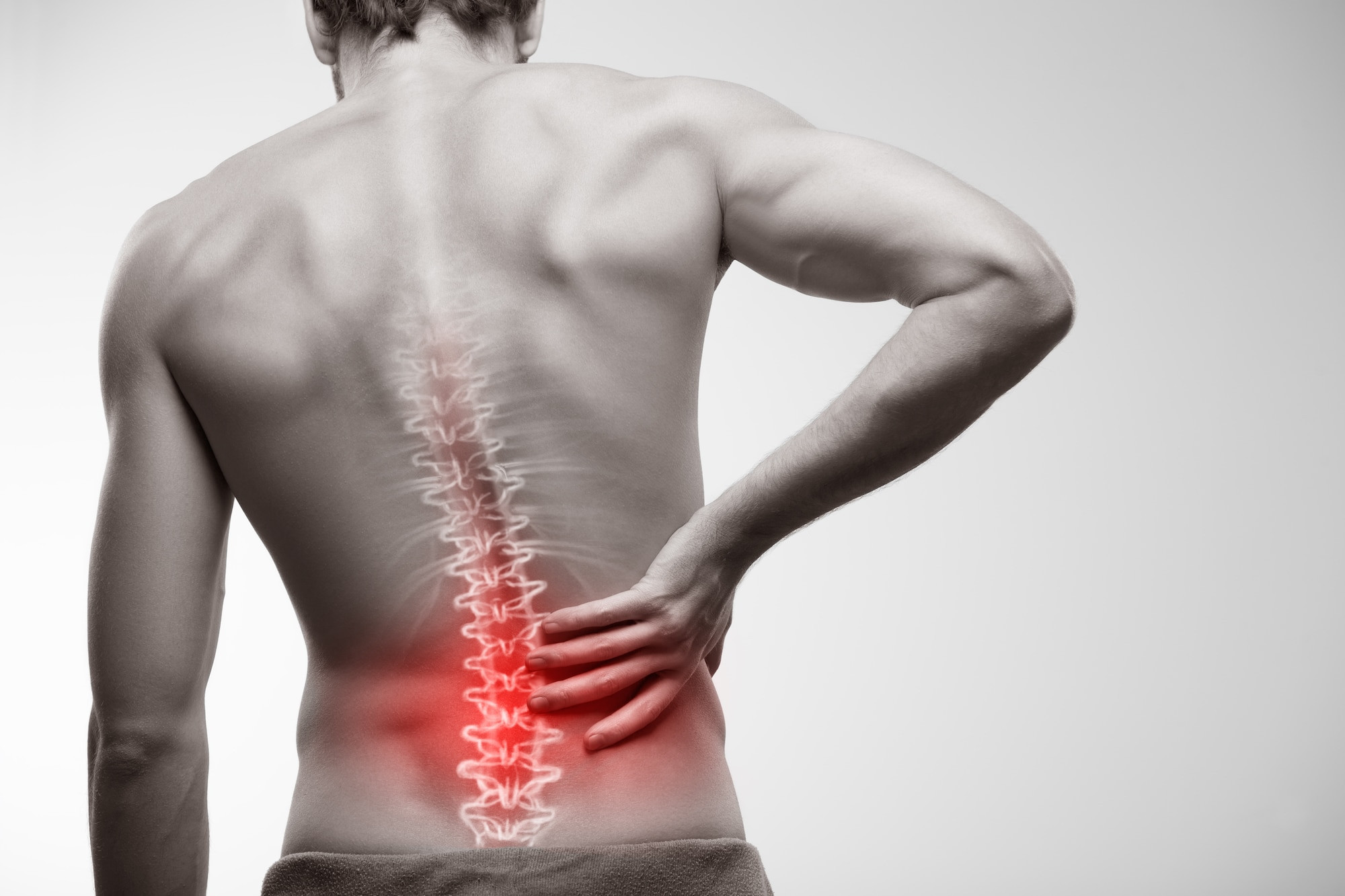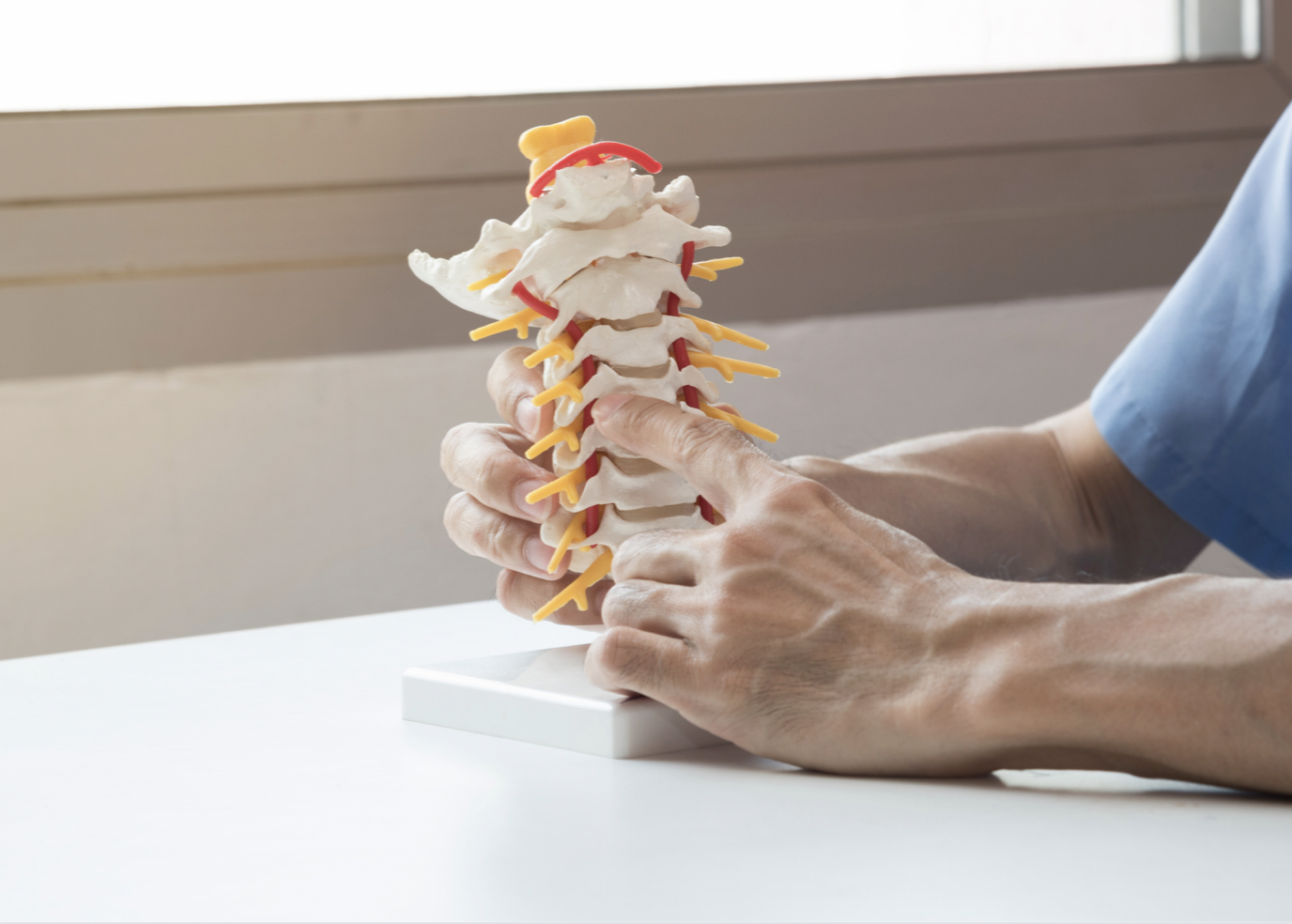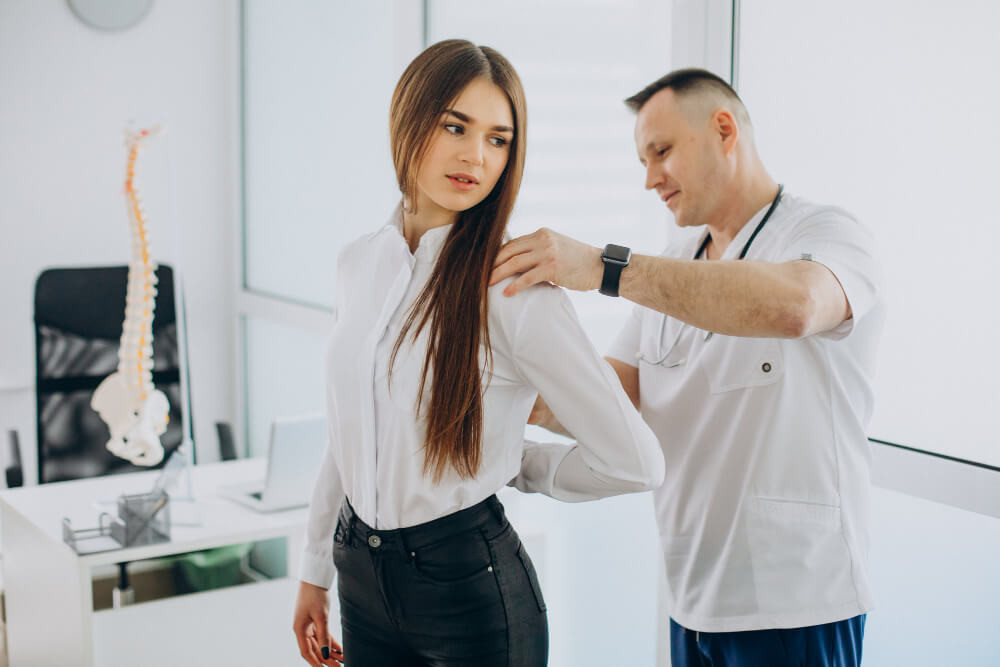Definition
Lower back pain, or low back pain, is one of the most common reasons people visit a doctor or miss work. It is also a leading cause of physical limitation worldwide. Fortunately, this issue can be prevented and managed with simple treatments in the early stages. Acute lower back pain can last from a few days to weeks, while chronic lower back pain persists for more than three months.
Lower back pain is more frequent in people aged 30-50 years. This occurs due to a reduction in joint fluid between the vertebrae as part of the aging process, making the spine prone to irritation. Additionally, muscle strength decreases, making the back more susceptible to injury.
Causes
Lower back pain often arises without a clear cause, necessitating a physical examination and other tests by the doctor. Common conditions associated with back pain include:
- Muscle or ligament strain: Repeated heavy lifting or sudden extreme movements can strain or tear the muscles and spinal ligaments. Continuous strain on the back can cause painful muscle contractions.
- Intervertebral disc problems: Discs are cushions between the vertebrae that allow us to stand and move our backs. They also distribute body weight during standing and walking, preventing fractures. The soft material inside the discs can bulge or rupture, pressing on nerves. Disc disease is often discovered incidentally during spine X-rays for other reasons.
- Arthritis: Conditions like osteoarthritis can affect the lower back. In some cases, arthritis in the spine can cause narrowing of the space around the spinal cord, a condition called spinal stenosis.
- Osteoporosis: This condition makes the vertebrae porous and brittle, leading to fractures and pain.
- Abnormal spinal curvature: Conditions like scoliosis (sideways curvature), kyphosis (hunchback), or lordosis (excessive inward curvature) cause pain due to pressure on muscles, tendons, ligaments, and vertebrae.
- Spinal cancer.
- Spinal infections.
- Kidney infections.
- Pregnancy: Back pain often resolves after childbirth.
Risk factor
Anyone can experience lower back pain, including children and teenagers. Risk factors include:
- Age: Lower back pain is more common with aging, starting around age 30 or 40.
- Lack of exercise: Weak, unused back muscles can lead to lower back pain.
- Excess weight: Excess weight puts extra stress on the back.
- Diseases: Some types of arthritis and cancer can cause lower back pain.
- Improper lifting techniques.
- Psychological conditions: People prone to depression and anxiety have a higher risk of lower back pain.
- Smoking: Smoking increases back pain as it induces more coughing, which can cause disc herniation. It also reduces blood flow to the spine, increasing the risk of osteoporosis.
Symptoms
Symptoms of lower back pain range from muscle aches to shooting or burning sensations. The pain may radiate down the leg or worsen with bending, twisting, lifting, standing, or walking.
Diagnosis
Doctors will examine your back and assess your ability to sit, stand, walk, and lift your legs. They will also ask you to rate your pain on a scale of 0-10 and describe how well you function with the pain. This helps pinpoint the source of pain, how much you can move before pain forces you to stop, and whether you have sudden muscle contractions. These assessments can also help rule out more serious causes of back pain.
If a specific condition is suspected, your doctor may suggest one or more of the following tests:
- X-rays: These show spine alignment and can reveal arthritis or fractures, but do not show problems with the spinal cord, muscles, nerves, or discs.
- MRI or CT scan: These can show herniated discs or problems with bones, muscles, tissues, tendons, nerves, ligaments, and blood vessels.
- Blood tests: These can identify infections or other conditions that may be causing the pain.
- Bone scan: Rarely used, this can detect bone tumors or compression fractures due to osteoporosis.
- Electromyography (EMG): This test measures electrical impulses from nerves and how muscles respond, confirming nerve compression from herniated discs or spinal stenosis.
Management
Most back pain improves within a month with home treatment, but this varies as back pain is a complex condition influenced by many factors. For some, pain persists for months, though severe, chronic pain is rare. Over-the-counter pain relievers may be used.
Complete bed rest is not recommended. Stay active as much as possible with light activities like walking. Avoid activities that increase pain but do not avoid activity due to fear of pain. If home treatments fail after several weeks, your doctor may suggest other medications or therapies.
Medications
Depending on your back pain, your doctor may recommend:
- Over-the-counter pain relievers: Nonsteroidal anti-inflammatory drugs (NSAIDs) like ibuprofen can relieve back pain. Use these as directed by your doctor to avoid serious side effects. If these do not work, your doctor may prescribe other medications.
- Muscle relaxants: These may be prescribed if mild to moderate back pain does not improve with pain relievers.
- Topical pain relievers: These deliver pain-relieving substances through the skin and are available as creams, ointments, or patches.
- Narcotics: These can be used for a short period under strict medical supervision.
- Antidepressants: Some types can relieve chronic back pain.
Physical therapy
Physical therapy improves flexibility, strengthens back and abdominal muscles, and corrects posture. Regular use of these techniques can help prevent recurrence. Physical therapists will also educate you on modifying movements to avoid prolonged pain while staying active.
Other procedures
Other treatments for back pain include:
- Corticosteroid injections: If other measures do not relieve pain and it radiates to the legs, doctors may inject a powerful anti-inflammatory drug into the space around the spinal cord (epidural space). The effects usually last one or two months.
- Radiofrequency neurotomy: A thin needle is inserted through the skin near the painful area. Radio waves pass through the needle to damage nearby nerves, interrupting pain signals to the brain.
- Implantable nerve stimulators: These devices, implanted under the skin, send electrical impulses to specific nerves to block pain signals.
- Surgery: Surgery may be needed if back pain does not improve, radiates to the legs, or is associated with progressive muscle weakness from nerve compression. This is typically for pain related to structural problems like spinal stenosis or herniated discs that do not respond to other therapies.
Alternative treatments
Several alternative treatments can relieve back pain symptoms. Always discuss the benefits and risks with your doctor before starting new alternative therapies.
- Chiropractic care: Chiropractors manipulate your spine to relieve pain.
- Acupuncture: Thin, sterile needles are inserted into specific points in the skin. Increasing scientific evidence supports acupuncture for back pain treatment.
- Transcutaneous electrical nerve stimulation (TENS): A battery-powered device placed on the skin delivers electrical impulses to painful areas. Studies show mixed results on TENS effectiveness.
- Yoga: This involves specific postures, breathing exercises, and relaxation techniques. Yoga can stretch and strengthen muscles and improve posture, though some poses may need adjustment to avoid worsening pain.
Complications
Lower back pain, especially chronic, can cause several complications, divided into medical, psychological, and social categories:
- Medical complications: These include cauda equina syndrome (compression of nerves at the lower spine), chronic pain, spinal deformities, and weight gain from inactivity.
- Psychological complications: These include depression, irritability, and insomnia from prolonged pain.
- Social complications: These include decreased activity, reduced productivity, and increased absenteeism.
Prevention
You can prevent back pain and its recurrence by improving your physical condition and practicing proper body mechanics. To keep your back healthy and strong, consider these steps:
- Exercise: Regular low-impact aerobic activities can increase back strength and endurance. Walking and swimming are good options. Consult your doctor on suitable activities.
- Build muscle strength and flexibility: Abdominal and back exercises will strengthen your core, functioning as a natural corset for your back.
- Maintain a healthy weight: Excess weight strains back muscles, making pain more likely.
- Quit smoking: Smoking increases the risk of lower back pain, with higher risks for heavier smokers. Quitting reduces this risk.
- Avoid twisting or stretching your back: Move correctly:
- Stand properly: Do not slouch. Keep your pelvis neutral. If standing for long periods, rest one foot on a low stool to relieve some lower back strain. Good posture reduces back muscle tension.
- Sit properly: Choose a seat with good lower back support, armrests, and a swivel base. Place a cushion or rolled towel at the back's curve to maintain normal lumbar shape. Keep your knees and hips level. Change positions frequently, at least every half hour.
- Lift correctly: Avoid heavy lifting if possible. If you must lift something heavy, let your legs do the work. Keep your back straight without twisting and bend only at the knees. Hold the load close to your body. Seek help if the object is too heavy.
Back pain is common, so many products promise prevention or cure. However, there is no solid evidence that special shoes, back supports, or stress management programs help. Additionally, there is no best mattress type for back pain sufferers.
When to see a doctor?
Most back pain improves with home treatment within a few weeks. Consult a doctor if your back pain:
- Persists beyond a few weeks.
- Is severe and does not improve with rest.
- Radiates to one or both legs, especially if it extends below the knee.
- Causes weakness, numbness, or tingling in one or both legs.
- Is associated with unexplained weight loss.
In rare cases, back pain can signal a serious medical issue. Seek immediate care if you experience:
- New bowel or bladder problems.
- Pain with fever.
- Pain following a fall, blow to your back, or other injury.
Looking for more information about other diseases? Click here!
- dr Ayu Munawaroh, MKK
The Mayo Clinic staff. (2020). Back Pain. Retrieved 23 November 2021, from https://www.mayoclinic.org/diseases-conditions/back-pain/diagnosis-treatment/drc-20369911
Low back pain fact sheet. (2020). Retrieved 23 November 2021, from https://www.ninds.nih.gov/Disorders/Patient-Caregiver-Education/Fact-Sheets/Low-Back-Pain-Fact-Sheet
Martel J. (2019). What should you know about low back pain. Retrieved 23 November 2021, from https://www.healthline.com/health/low-back-pain-acute
Slideshow: a visual guide to low back pain. (2019). Retrieved 23 November 2021, from https://www.webmd.com/back-pain/ss/slideshow-low-back-pain-overview
Back pain. (2020). Retrieved 23 November 2021, from https://www.nhs.uk/conditions/back-pain/
Hills EC. (2020). Mechanical low back pain. Retrieved 28 November 2021, from https://emedicine.medscape.com/article/310353-overview#a1
Chawla J. (2018). Low back pain and sciatica. Retrieved 28 November 2021, from https://emedicine.medscape.com/article/1144130-overview#a1
Casiano VE, Dydyk AM, Varacallo M. (2020). Back pain. Retrieved 28 November 2021, from https://www.ncbi.nlm.nih.gov/books/NBK538173/












